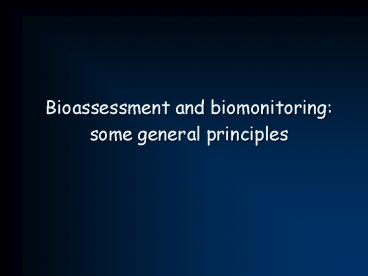Bioassessment and biomonitoring: PowerPoint PPT Presentation
1 / 26
Title: Bioassessment and biomonitoring:
1
- Bioassessment and biomonitoring
- some general principles
2
- Whats the difference?
- Bioassessment
- - the use of living organisms to assess aspects
of the integrity (condition, health) of the
environments in which they live - OR
- - the process of determining if human activity
has altered the biological properties of an
ecosystem
3
- Biomonitoring
- the use of living organisms to track conditions
in the environments in which they live - OR
- the systematic use of biological responses to
evaluate environmental changes within a
quality-control programme
4
- A metric is a value calculated from a particular
set of measurements. - An indicator is a feature (biological, physical,
chemical, a metric, an index) that reflects
specific condition or change in condition. - An index is a numerical indicator derived from a
series of metrics.
5
- Indices can be based on metrics derived from
- the biota
- e.g. SASS (inverts) VEGRAI (riparian veg.)
- or
- physical features
- e.g hydrological, habitat indices
- or
- mixed features
- e.g. WetEcoservices derived from
socio-economic biotic indices
6
- Bioassessment uses components of the biota to
reflect aspects of e.g. - - water chemistry
- - hydrology (e.g. water level)
- - availability of nutrients
- - ecosystem integrity (health)
- - suitability for particular purposes (i.e.
quality) etc. - e.g. the Saprobien Index organic
pollution
7
Why bioassessment?
- While chemical and physical analyses are
- - reliable (accurate, repeatable)
- - provide instant snapshots
- They are
- - limited to the period of sample collection
- - limited to the constituents measured
- - expensive (if comprehensively done)
- - limited by sensitivity of the methods used
low concentrations cannot be detected.
8
- Living organisms
- - provide a longer-term view
- - are continuous monitors they integrate
effects of time and multiple pollutants - - can be cheap and easy to assess
- - can be used for different purposes
- - account for synergistic (magnifying) and
antagonistic (reducing) effects (e.g. pH)
9
Where does ecotoxicology fit in?
- The study of the effects of toxic substances on
aquatic organisms - usually laboratory-based experiments
- link between WQ and its effects on the biota
e.g. used for deriving guidelines - includes field studies
- bioaccumulation / biomagnification active
biomonitoring - use of biomarkers
10
Which organisms to use in bioassessment?
Protozoa /diatoms identification
specialised Algae / periphyton Macroinvertebrates
Fish Macrophytes Birds
11
- First ask,
- WHAT DO WE WANT THE
- BIOTA TO TELL US??
- i.e. what are we monitoring FOR?
12
- e.g. it can provide a measure of change
- We can monitor specific features, usually at
fixed points - e.g. edges between veg. types water
level degree of sedimentation fixed-point
photography geomorphology of
channels density of aliens aspects of
ground water
13
- Individual species as indicator species
- e.g. halophytes halophobes tolerators of
low pH - rapid responders to changes in nutrient
levels those whose eggs must
desiccate before hatching ruderal
species
14
- Can use assemblages
- e.g. diatoms (good for aspects of water
chemistry) - odonates (IBI?)
- molluscs (IBI?)
- macrophytes (hydroperiod / water level)
- macro-invertebrates (generalized
impairment of water quality)
15
- What criteria are important when selecting
techniques / indicators? - - rapidity ( therefore cost)
- - narrowness of tolerance ranges
- - common-ness (or even rarity)
- - ease of identification
- - life cycle of the right length
16
- What methods of analysis?
- What taxonomic level of identification?
- What numerical methods
- simple arithmetic (e.g. SASS)?
- multivariate analyses (e.g. AusRivas,
Rivpacs) predictive modelling? - Validation of proposed indices?
- What level of confidence is necessary?
17
- What can biomonitoring NOT do??
- It cannot replace phys chem. data (it
complements it) - It does not explain the cause of the problem,
merely indicates that there is one - It seldom predicts outcomes (but indicates
trajectory of change).
18
THE NATIONAL WETLAND RESEARCH PROGRAMME
- PHASE II WETLAND HEALTH AND INTEGRITY
19
Development of the WHI research programme
- Strategic overview of research needs in wetlands
- Malan and Day (2005) Strategic overview of the
research needs for wetland health and integrity.
WRC Report no. KV 171/05. - Malan, Day Marr (2005) Assessment of wetland
ecological health and socio-economic importance
an annotated bibliography. WRC Report no. KV
172/05
20
Aims of the WHI research programme
- To develop tools for assessing
- - ecological condition
- - aspects of the biophysical environment (e.g.
water quality, hydroperiod) - - socio-economic importance
- - loss of wetland function through degradation
21
THE INDIVIDUAL PROJECTS
DIATOM INDEX Development of an index based on
diatoms - commonly used for aspects of water
chemistry
MACROPHYTE INDEX Development of an index of
biotic integrity / ecosystem condition based on
macrophytes - consolidation of plant species
lists individual species as indicators of
specific conditions (e.g. high salinity or low
pH)
22
- INVERTEBRATE INDEX
- To investigate the feasibility of developing an
index of wetland health using invertebrates - - PhD project
DRY CONDITION INDEX - identification of
non-perennial wetlands - assessment of their
condition / integrity in the dry state Use of
macrophytes? invertebrates? diatoms?
23
TESTING OF EXISTING TOOLS critique/gap
analysis - WET-EcoServices (index of
functionality) rapid evaluation of wetland
goods services - WET-Health (a type of
IBI) - Ecological Importance and
Sensitivity (to be used by DWAF)
24
DEPENDENCY METRIC Development of a metric of
socio-economic dependency of communities on a
wetland SUSTAINABILITY METRICS effect of
human use on - ecosystem functionality - sustai
nability use of a wetland
25
LOSS-OF-FUNCTION METRIC Relationship between
function and extent of degradation
LANDSCAPE-LEVEL IMPACTS The cumulative impact of
wetland loss at the landscape level
26
(No Transcript)

